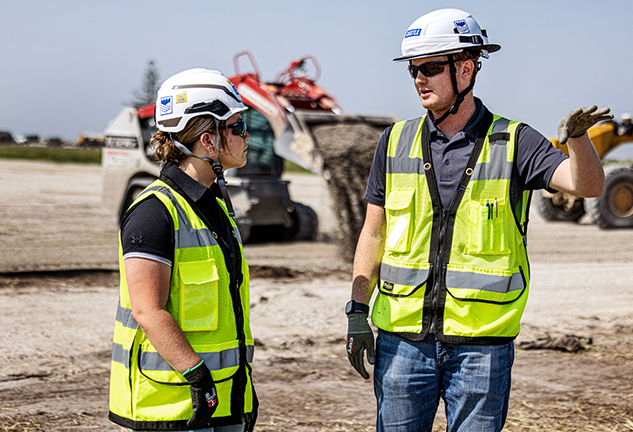The Human Element: Technology Can’t Replace Experience and Ingenuity

Technology continues to transform the construction industry as it automates manual processes, improves communication and boosts efficiency.
The people at Castle have always embraced emerging technologies — from GPS and drones to 3D software and new communication platforms.
Now, with the advent of artificial intelligence (AI) and machine learning, the industry has entered a new domain of sophistication that brings with it equal parts anticipation and apprehension.
While it remains to be seen how these sophisticated tools will impact the day-to-day management and delivery of civil construction jobs, some might wonder whether AI could someday replace humans.
At Castle, that’s not likely to happen.
Our business is — and always will be — a hands-on enterprise that relies on human skill, expertise and ingenuity.
Rather than removing humans from the equation, AI and machine learning have the potential to take over the more monotonous tasks and assist our people in doing the core functions of their jobs more effectively.
Leveraging New Technology in Construction
Since joining Castle as a college intern in 2014, Project Manager Zach Kelly has been on the front lines of exploring new technology applications. As the company’s first licensed drone pilot, Kelly was instrumental in expanding Castle’s early use of these unmanned aerial vehicles to conduct topographic surveys of jobsites. Today, Castle has several drone pilots on staff and regularly uses drones to visualize and track the progress of its earthwork projects.
Though drones can complete this task in a fraction of the time it takes to walk a site and conduct a traditional land surveying process, it isn’t a foolproof system. “A drone is only as good as the information you give it to work with,” Kelly says. “If the ground control points are off, something blocks the signal or we've got a gap in our data, it can throw off the results.” And, as he’s discovered, challenging sites such as an undeveloped grassy field can conceal a ditch, hole or mound that isn’t detected by a drone. “That’s why it’s important to have some other verifications and checks and balances in place,” he says.
Connecting with People
Technology helps Survey Technician Steve Brewster engage with equipment operators in the field—whether they’re located down the street or across the country.
His role includes equipping field personnel with the digital plans that guide their work and helping them troubleshoot any issues they may experience.
And he doesn’t need to leave his desk to do so. “Rather than having to physically drive to a jobsite, we can equip devices with a SIM card,” he says. “That has expanded the number of people I can help and improved the office-to-field connection.”
To provide real-time technical support to operators, Brewster also has the ability to remote into the devices used on individual machines and screen share with them.
“There’s no doubt that technology continues to automate and improve our work in the field, but I think key decisions will always have to be made by people on the job,” he says.
Harnessing Efficiency
Over the course of his 20-year career as a civil engineer, Castle Senior Design Manager James Parks, P.E., has experienced numerous technology advances, including the transition from two-dimensional software to 3D software that assists with design, clash detection and integration with other disciplines.
But new technology isn’t a substitute for hands-on project experience. “The experience of our team is paramount. We’ve solved a lot of design challenges, and that expertise means we have encountered most scenarios and developed the knowledge to approach them effectively,” he says. “As complicated as civil engineering and site development is, we know all the elements that need to be considered and make sure we develop constructible designs that achieve the project goals in the physical world.”
While Parks is intrigued by the future of technology, he doesn’t believe it’s capable of replacing the complex, nuanced parts of his job. “There are tools to help us capture preliminary information to start our due diligence process as well as optimization features within our civil design software that expedite getting to a starting point for a conceptual design,” he says. “These advancements are a great help, but the output is nowhere near a complete deliverable. Engineers have the responsibility to dig into the generated information for accuracy, thoroughness, synthesis and application. We also have local rules and requirements specific to each project and engineering standards that we must apply to ensure the quality and detail of a design.”
And technology isn’t likely to replace the interactive process of engaging with stakeholders. “I don’t know that AI would be able to successfully answer questions about design concepts on the fly at a Board of Aldermen or planning commission meeting,” he says.





